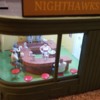Great project, and great history.
Not that anybody asked, but:
There is an interesting story behind the "non-grid" streets that can be found in NYC. At the time that the 1811 municipal grid system was established for the streets north of Houston, there were already several significant housing developments uptown--way out in the sticks. Each of these had chosen its own street grid. So, when you see "off-grid" streets, they are "fossil remains" of these old communities.
The 1811 grid follows the major axis of the island, so it is sort-of-but-not-quite North-South (with Broadway being the obvious and deliberate exception). But the older communities had made their own choices. For example, a community called "Bowery Village" used magnetic north-south as its major axis. Stuyvesant Street in the East Villiage is a remnant of this grid. If you stand at the corner of Stuyvesant and 10th St, the former looks slanted, but it is really the rest of the island that is off! Greenwich Villiage also existed before 1811, and its grid went diagonally from NW to SE. So THAT is why "Nighthawks" is askew.
Just thought you might want to know...







